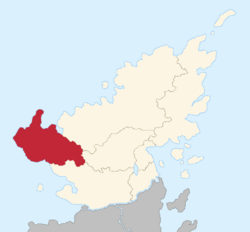Wilskland: Difference between revisions
(Created page with "{{Infobox settlement | name = Independent State of Wilskland | native_name = Teinžé Wyélš (Wilsk)<br>Danija ytan á Wyél...") |
mNo edit summary |
||
| Line 110: | Line 110: | ||
}} | }} | ||
'''Wilskland''' ([[Wilsk language|Wilsk]]: Wyélš; [[Seketese language|Seketese]]: Wyélsytan), [[Constitution of Seketan|constitutionally]] recognized as the '''Independent State of Wilskland''' ([[Wilsk language|Wilsk]]: Teinžé Wyélš; [[Seketese language|Seketese]]: Danija ytan á Wyélsytanya), is a [[provinces of Seketan|province]] of [[Seketan]] with [[government of Wilskland|special status]]. The province forms a [[Wilsk peninsula|peninsula]], forming a large coastline surrounded by the {{wp|Atlantic Ocean}}. It neighbours [[Bynan]] to the south | '''Wilskland''' ([[Wilsk language|Wilsk]]: Wyélš; [[Seketese language|Seketese]]: Wyélsytan), [[Constitution of Seketan|constitutionally]] recognized as the '''Independent State of Wilskland''' ([[Wilsk language|Wilsk]]: Teinžé Wyélš; [[Seketese language|Seketese]]: Danija ytan á Wyélsytanya), is a [[provinces of Seketan|province]] of [[Seketan]] with [[government of Wilskland|special status]]. The province forms a [[Wilsk peninsula|peninsula]], forming a large coastline surrounded by the {{wp|Atlantic Ocean}}. It neighbours [[Bynan]] to the south, [[Nelderjen]] to the east, and [[Giorgi-Alesk]] to the northeast. The capital and largest city is [[Fyedor]]. With a population of 1,079,393, it is the third-most populated province of Seketan. | ||
[[History of Wilskland|Wilsk history]] spans more than a millennium. Wilskland first formed from [[Winnics|Winnic culture]] whom formed the [[Kingdom of Wilskland]], which later [[Christianization of Seketan|Christianized]] into the [[Duchy of Wilskland]]. The Wilsk and Seketese monarchs entered in {{wp|personal union}} in 1577. Wilskland retained political sovereignty under the {{wp|suzerainty}} of Seketan; this lasted until the [[Wilsk Republic]] federated with the [[First Seketese Republic]] to form [[Second Seketese Republic|a federal republic]] in 1924. The [[Wilsk Representation Movement]] from 1942 to 1945 largely contributed to the establishment of the [[Third Seketese Republic]], whose reforms included constitutionally recognizing the Wilsk right to self-determination and Wilsk representation in the [[Hérvynsken]]. During [[Zemasy]] and the collapse of the [[Kjedorate regime]] in Seketan, [[Wilsk insurgency|Wilsk nationalist insurgencies]] arose under a wave of [[Wilsk nationalism]] that remains an important factor in [[Politics of Wilskland|Wilsk politics]] today. | [[History of Wilskland|Wilsk history]] spans more than a millennium. Wilskland first formed from [[Winnics|Winnic culture]] whom formed the [[Kingdom of Wilskland]], which later [[Christianization of Seketan|Christianized]] into the [[Duchy of Wilskland]]. The Wilsk and Seketese monarchs entered in {{wp|personal union}} in 1577. Wilskland retained political sovereignty under the {{wp|suzerainty}} of Seketan; this lasted until the [[Wilsk Republic]] federated with the [[First Seketese Republic]] to form [[Second Seketese Republic|a federal republic]] in 1924. The [[Wilsk Representation Movement]] from 1942 to 1945 largely contributed to the establishment of the [[Third Seketese Republic]], whose reforms included constitutionally recognizing the Wilsk right to self-determination and Wilsk representation in the [[Hérvynsken]]. During [[Zemasy]] and the collapse of the [[Kjedorate regime]] in Seketan, [[Wilsk insurgency|Wilsk nationalist insurgencies]] arose under a wave of [[Wilsk nationalism]] that remains an important factor in [[Politics of Wilskland|Wilsk politics]] today. | ||
Revision as of 02:07, 15 November 2021
Independent State of Wilskland
| |
|---|---|
 Location of Wilskland in Seketan | |
| Country | Seketan |
| Population (1 January 2020) | |
| • Total | 1,079,393 |
Wilskland (Wilsk: Wyélš; Seketese: Wyélsytan), constitutionally recognized as the Independent State of Wilskland (Wilsk: Teinžé Wyélš; Seketese: Danija ytan á Wyélsytanya), is a province of Seketan with special status. The province forms a peninsula, forming a large coastline surrounded by the Atlantic Ocean. It neighbours Bynan to the south, Nelderjen to the east, and Giorgi-Alesk to the northeast. The capital and largest city is Fyedor. With a population of 1,079,393, it is the third-most populated province of Seketan.
Wilsk history spans more than a millennium. Wilskland first formed from Winnic culture whom formed the Kingdom of Wilskland, which later Christianized into the Duchy of Wilskland. The Wilsk and Seketese monarchs entered in personal union in 1577. Wilskland retained political sovereignty under the suzerainty of Seketan; this lasted until the Wilsk Republic federated with the First Seketese Republic to form a federal republic in 1924. The Wilsk Representation Movement from 1942 to 1945 largely contributed to the establishment of the Third Seketese Republic, whose reforms included constitutionally recognizing the Wilsk right to self-determination and Wilsk representation in the Hérvynsken. During Zemasy and the collapse of the Kjedorate regime in Seketan, Wilsk nationalist insurgencies arose under a wave of Wilsk nationalism that remains an important factor in Wilsk politics today.
Wilsks form an independent national identity and often represent themselves in regional organizations and sports leagues. Wilsk nationalism and separatism play a large role in the politics of Wilskland. The culture of Wilskland is vast and the province has its own media, art, music, cinema,
The Irvansky is the unicameral parliament of Wilskland, and it is politically represented in both houses of the Hérvynsken. Under the constitution of Seketan, Wilskland is governed by Wilsk law. The official language is Wilsk, although Seketese is widely spoken as a second language. Its economy is highly diversified and is influenced by Wilsk economic protectionism.
